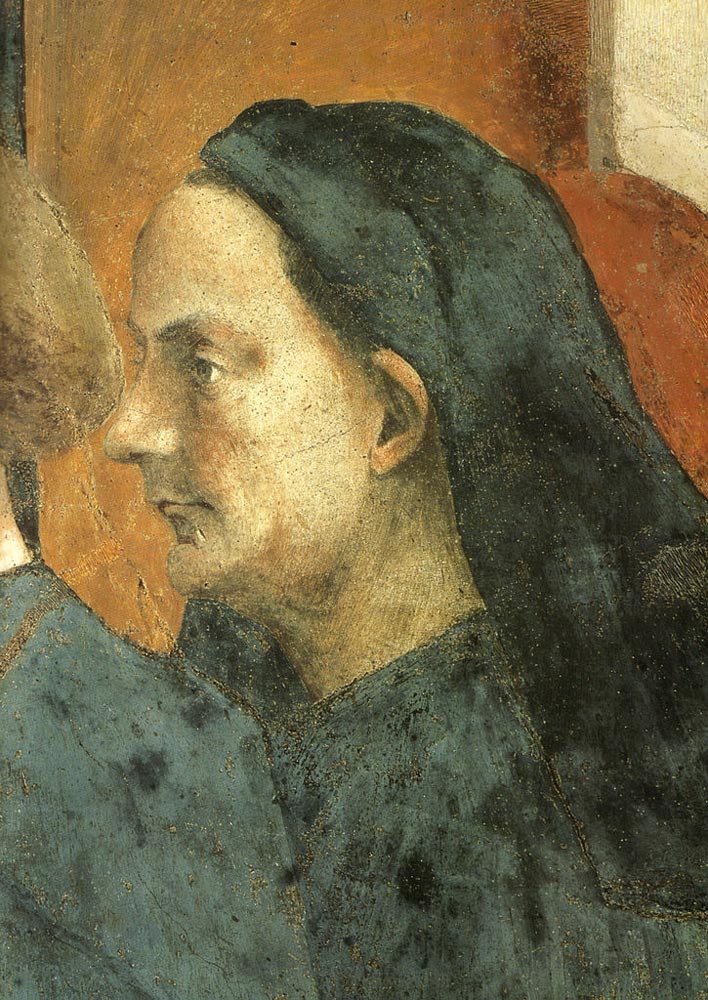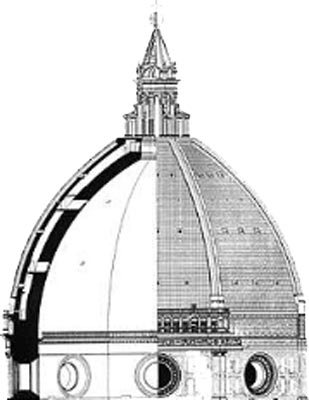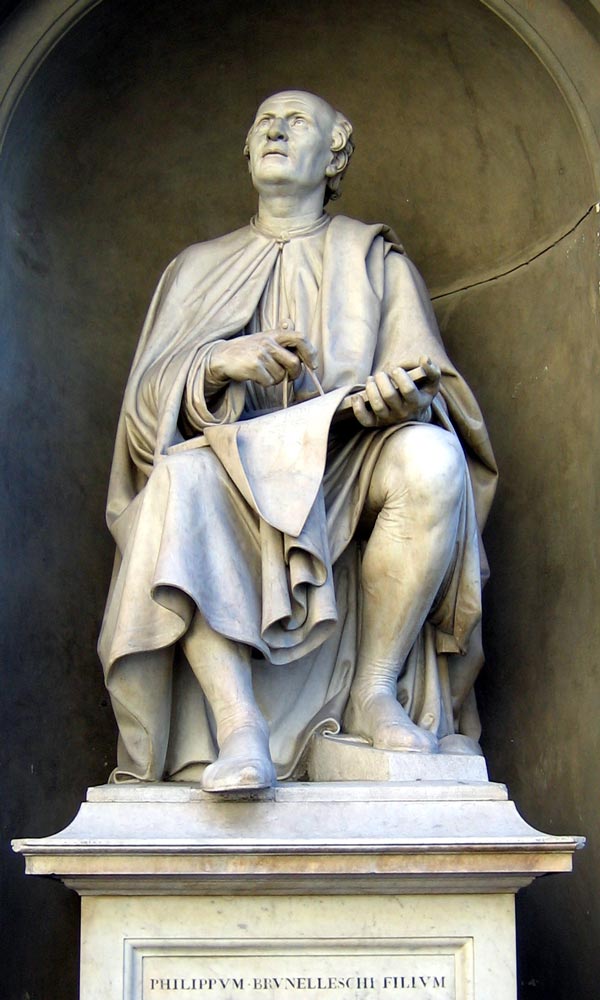| Filippo Brunelleschi | |
|---|---|
 |
|
| Born | Filippo di ser Brunellesco di Lippo Lapi 1377 Florence, Italy |
| Died | April 15, 1446 (at age 68–69) |
| Nationality | Italian |
| Movement | Early Renaissance |
| Field | Architecture, Sculpture, Mechanical engineering |
| Works | View Complete Works |
Filippo Brunelleschi (1377-1446), a Florentine architect and sculptor, can be credited for helping to create the Renaissance style in architecture. His original and daring ideas in architecture, engineering and linear perspective made him the most well-known and respected architect of his time, and the most inventive and gifted artist of all time. His most famous work, the designing and building of the dome for the Santa Maria del Fiore Cathedral in Florence, Italy, revolutionized engineering and construction, and was the largest dome in the world for almost five-hundred years. Designing and building the dome, lantern, and exedra for the cathedral, occupied the majority of his artistic life.
The Young Filippo Brunelleschi
Filippo was the middle of three children born in Italy, to Brunelleschi di Lippo, a lawyer and his wife. At a young age, he was schooled with literary and mathematical backgrounds to follow his father as a civil servant. Filippo was artistically inclined however, and attended the Arte della Seta, or silk merchants’ guild, which included training for metal workers, goldsmiths, and bronze workers. There he had an apprenticeship as a goldsmith in 1392. He became a master goldsmith in 1398, but very little is known about Brunelleschi’s transition from master goldsmith to his training in gothic or medieval architecture.
In 1401, Brunelleschi entered a competition to design a new set of bronze doors to adorn the Florence Baptistery, a minor basilica in Florence. His competitor Lorenzo Ghiberti won the honors of the commission. From 1402-1404, Brunelleschi and Donatello, a fellow painter and sculptor, traveled to Rome in order to study the ancient Roman ruins. Brunelleschi gained inspiration from Roman architecture, and ancient Roman authors who provided an intellectual understanding for the still visible structures. He also developed a fascination with the Pantheon, studying, climbing, and formulating ideas of how to build a dome.
While in Rome, he began to understand how objects are perceived by the human eye, using correct proportion to the distance in which they are shown in art. Carrying out a series of optical experiments, Brunelleschi was responsible for introducing linear perspective in art, using a unified vanishing point. Brunelleschi’s first major building commission was the Ospedale Degli Innocenti in1419. This building located in Florence which was originally a children’s orphanage, was a notable example of his early Italian Renaissance architecture. The building featured a nine-bay loggia, with impressive arches.
Brunelleschi and the Florence Cathedral Dome
 In 1419, Arte della Lana, or the wool merchants’ guild, held a competition which was centered around standing an egg upright on a slab of marble. Brunelleschi and his rival Ghiberti both competed, and Brunelleschi won by breaking one end of the egg, making it rest upon the marble with stability. Although the fathers were skeptical, making light of his tactics, Brunelleschi received the commission to build the dome for the Santa Maria del Fiore Cathedral.
In 1419, Arte della Lana, or the wool merchants’ guild, held a competition which was centered around standing an egg upright on a slab of marble. Brunelleschi and his rival Ghiberti both competed, and Brunelleschi won by breaking one end of the egg, making it rest upon the marble with stability. Although the fathers were skeptical, making light of his tactics, Brunelleschi received the commission to build the dome for the Santa Maria del Fiore Cathedral.
A dome of this multitude had not been built for ages, and buttresses, or architectural supports were forbidden by the city fathers, so constructing a dome of this size without risk of it collapsing was a monumental challenge. There was not enough wood in the city for a wooden structure, and mortar of this time period took several days to set. Brunelleschi therefore used sandstone beams and bricks for the inner and outer domes. Using his technical and mathematical genius, he invented a hoist to lift these beams and bricks made of sandstone, hundreds of feet into the air. This was the first hoist ever equipped with a reverse gear, and one in which even DaVinci admired.
This magnificent dome took sixteen years to construct. The completed dome weighed 37,000 tons, and consisted of over 4 million sandstone bricks. The dome is made up of two octagonal vaults, with one inside the other. This shape was dictated by the structure. The dome also features architectural reliefs, circular windows, and a lantern and exedra. The lantern at the summit of the cupola was completed in 1461, and four decorative exedrae were completed after Brunelleschi’s death. In 1436, the Pope declared the Santa Maria del Fiore Cathedral to be sacred, and Brunelleschi was buried beneath his greatest accomplishment, although his tomb was not discovered until 1972.
Linear Perspective
Brunelleschi was famous for two panel paintings, which illustrated geometric optical linear perspective. He demonstrated perspective by painting the outlines of chosen Florentine architectural structures onto a mirror, noting that all lines converged on the horizon. Soon after this introduction, nearly all of the Florentine artists used perspective in their paintings. To demonstrate perspective, observers would look through a small hole Brunelleschi bore through the back of one of his panels. When looking through this hole, a mirror was positioned, reflecting the painting front, so that the front of the painting was on the mirror, showing perspective. Brunelleschi’s painting was the first accurate use of perspective in painting at that time.
Other Principal Works
 While working on the construction of the cathedral’s great dome, Brunelleschi was commissioned to do a great deal of architectural designing. He was commissioned to design the Basilica di San Lorenzo di Firenze in 1419, although the building was not completed until after his death. In 1420, he accepted the commission for the first floor of the headquarters for the Guelph party, or factions supporting the Pope and the Holy Roman Emperor. In 1421, he was commissioned by the Medici family to design the Sagrestia Vecchia. It is a prime example of Brunelleschi’s study of ancient Roman architecture, and decorative details were added by his fellow artist Donatello.
While working on the construction of the cathedral’s great dome, Brunelleschi was commissioned to do a great deal of architectural designing. He was commissioned to design the Basilica di San Lorenzo di Firenze in 1419, although the building was not completed until after his death. In 1420, he accepted the commission for the first floor of the headquarters for the Guelph party, or factions supporting the Pope and the Holy Roman Emperor. In 1421, he was commissioned by the Medici family to design the Sagrestia Vecchia. It is a prime example of Brunelleschi’s study of ancient Roman architecture, and decorative details were added by his fellow artist Donatello.
Twenty years later, while still constructing the infamous dome, Brunelleschi was commissioned to design the Santo Spirito di Firenze, which was to be constructed over the thirteenth century Augustinian priory, destroyed by fire. Design began in 1428, and construction began after his death. The Pazzi Chapel, commissioned in 1441, was also based on geometric forms of Brunelleschi’s design. Brunelleschi’s superb skill and exceptional talents are still admired in Italian architectural structures. His techniques, which were often thought to be impossible, were the foundation of the Renaissance era of architecture.